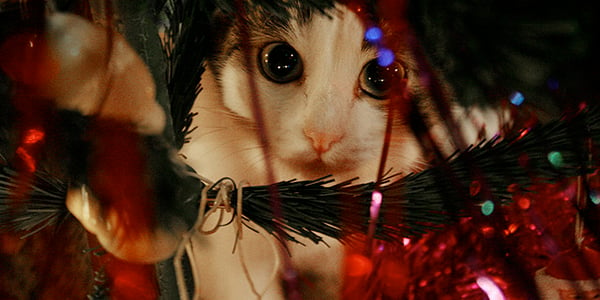 Is it just me, or do the holidays always seem to sneak up each year? Wasn't it just Halloween?!?!
Is it just me, or do the holidays always seem to sneak up each year? Wasn't it just Halloween?!?!With so much to do to prepare yourself and your home for Christmas, it can be easy to forget that the holiday season can also affect your pets.
Sure they don't have gifts to get, rooms to clean, and food to cook ... but their daily routine is often upset and stressed out by all the holiday commotion all the same. And that's before we even get into all the potential pet hazards on your holiday table and under (or on) your tree!
With a little bit of knowledge of dangers to look out for and minimize, you can rest easier when the festivities begin knowing that your pets are all snuggled up and safe, ready to bring joy and laughter to your home and heart.
The Holiday Feast
For many of us, celebrating the holidays and eating good food are synonymous. Just like at Thanksgiving, many of the foods that we enjoy at Christmas and the other winter holidays can be problematic for our pets.
Chocolate
Chocolate is a common gift this time of year, and it’s present in many baked goodies as well. Did you know though that chocolate can be toxic for cats and dogs (the linked article goes into "why" and which chocolates are the most dangerous). Here are some tips to make sure you don’t end up in the animal emergency room with a pet suffering from chocolate poisoning.

- Don't leave chocolate (or chocolate-containing foods) under the tree. Wrapped or not, your pets are sure to sniff them out and help themselves. Advise your friends, family, and other guests of this too!
- Be careful what 'stuffers' you put in the stockings, and be sure to hang them well out of reach of your pets.
- Don't leave desserts out on low-lying tables or near the edge of countertops. Be sure your guests and children are similarly cautious.
- Be careful when doing the holiday baking... from chocolate chips (especially if dark) and chocolate bars to cocoa powder and blocks of chocolate, holiday baking often includes chocolate in quantities that can easily land your pet in the Animal ER.
- Make sure your overnight houseguests keep their suitcases and other bags off the floor and that they keep the door to their room (and bathroom) securely closed as well. After all, you never really know what overnight guests bring in their suitcase, do you?
Currants & Raisins
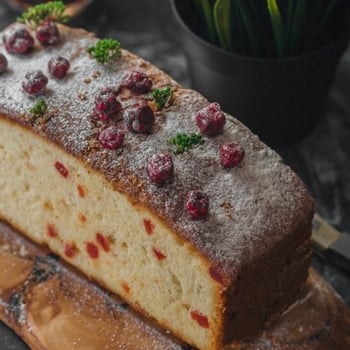
Though the traditional fruitcake (a.k.a. "doorstop") has mostly gone out of fashion, there are a number of other popular holiday desserts that contain currants and raisins, including various cookies and cakes, like yummy Stollen, Panettone, and Christmas Puddings.
While these dried fruits can add a little sweet chewiness to your desserts, they can also be highly toxic to your dog’s kidneys. Not all dogs are affected by the toxin, and we don't yet know what the exact toxin is. However, in the dogs that are affected, the result can be devastating, permanent, expensive, and a potentially fatal case of acute renal (kidney) failure. And note that grapes can also cause this same problem in dogs.
Learn more about grape, raisin, and currant toxicity in dogs here.
Nuts
It's important to keep all nuts out of your pet’s mouth (as any nut can be a choking hazard or even cause pancreatitis or an intestinal obstruction), but one type of nut, in particular, can carry additional dangers for your dogs.
Given their potent punch of low carbs, healthy fats, and important vitamins and minerals, macadamia nuts are a popular snack during the holidays and on the keto diet. But macadamia nuts can cause tremors, high fever, and a temporary loss of use of the back legs in dogs.
And this is in addition to their ability to cause pancreatitis (due to the high fat content) and the intestinal obstruction risk that these (and other nuts) can cause when a dog eats them. Because of this, it's good to take extra precautions to keep these nuts off of coffee tables, counters, and other areas that might be in your dog’s reach. And that precaution goes even double if those macadamia nuts are covered in chocolate, as so many are! Learn more about nuts and dogs.
Allium Vegetables
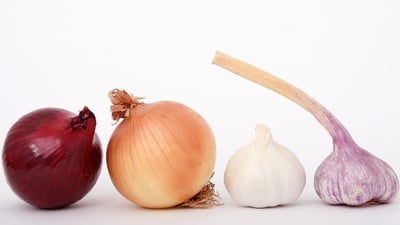
Allium veggies are the species of plant that include onion, garlic, leeks, shallots, and chives. Whether cooked or uncooked, these popular veggies can be toxic to your dog or cat.
In small quantities these vegetables aren’t likely to cause too big a problem for your cats and dogs, but in larger quantities, or if your pet already has a low red blood cell count (anemia) or dysfunctional red blood cells, ingestion of onions or garlic can prove both debilitating and expensive.
Natural compounds in these popular seasonings can cause destruction of your pet's red blood cells in a process called hemolytic anemia. Given all of the important functions that red blood cells serve in the body, it's definitely not a thing you want your pets to suffer from.
Your pet may show initial symptoms of vomiting and diarrhea, but as the problem progresses, they'll typically exhibit rapid, shallow breathing, a fast pulse rate, weakness, and either pale white or yellowish gums. Hemolytic anemia is a serious medical emergency.
Alcohol

While you'd never feed your pet alcohol, certain desserts contain alcohol, and it doesn’t take much for someone to leave their drink on a coffee table and within reach for a dog (or a cat for that matter).
Similar to the effects it can have on people, alcohol can cause several problems in your dogs and cats. It can lead to both metabolic and neurologic problems in your pets that can result in vomiting, breathing problems, coma, and even death. So be sure to keep the wine glasses, cocktails and alcohol-soaked desserts off the low-lying tables.
Xylitol
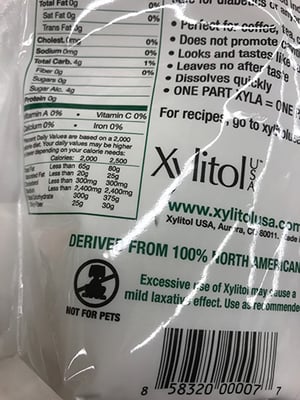
Xylitol is an increasingly common sugar-replacement sweetener that's in hundreds of products, including some brands of peanut butter. It's an “all-natural” sugar substitute that’s fine for people but is extremely poisonous to dogs and poisons thousands of dogs each year.
There has been an increase in awareness about xylitol — both in peanut butter and in the more than 700 other products xylitol is found in — and we have been able to influence some companies to change their labeling and warning practices.
Usually, the biggest culprit of xylitol poisoning in dogs is sugar-free gums and mints. Around the holidays, though, and with more and more people trying to eat less sugar, many people are baking with xylitol!
So watch where you put your sugar-free or low-carb baked goods, and make sure your counters are clear if you've got a counter-surfing dog!
Because it's such a strong stimulator of insulin release in dogs, it takes just a small amount of xylitol (0.1g/kg) eaten by a dog to cause a dangerous drop in blood sugar ("hypoglycemia"). This will typically initially show as vomiting, weakness, and a lack of coordination. As hypoglycemia progresses, you can see seizures, coma, and even death. Xylitol can cause an extremely dangerous drop in your dog's blood sugar in as little as 30 minutes!
At slightly higher doses (but still relatively small), xylitol can also cause devastating liver failure in some dogs. It's truly nasty stuff for dogs, so please read labels and learn more about the dangers of xylitol to dogs.
Plants & Flowers
Flowers and plants are common host gifts. Whether you’re the one giving flowers or the one receiving them, it’s important to know that many commonly given plants and flowers can cause problems for cats and dogs, as such poisonings can range in severity from mild digestive upset to organ failure.

Poinsettia
Ironically, poinsettias, one of the more well-known-about holiday plant hazards for pets, aren’t actually that hazardous to pets. Due to the low level of toxicity seen with poinsettia ingestion, medical intervention is rarely needed unless signs are severe.
- Mild signs will include vomiting, drooling, or rarely diarrhea.
- Milky sap can irritate skin, causing redness, swelling, and itchiness.
Cyclamen

Although not nearly as popular as poinsettias around the holidays, cyclamen is often found in homes this time of year. And not many people know about the dangers of the cyclamen.
Seeing as how they are readily available at supermarkets and garden stores (and rather inexpensive), cyclamen can be a common holiday decoration or hostess/host gift.
The toxins of the cyclamen can cause a wide range of problems for the pets that ingest them, ranging from excessive salivation and digestive upset to seizures and heart rhythm abnormalities. In small ingestions, most pets will suffer only mild digestive upset. However, in cases of large ingestion, this toxicity can prove fatal.
Lilies

Although lilies don’t exactly ‘scream’ Christmas, flowers do! Lilies are amongst the most common types of flowers found in bouquets at all times of the year, including Christmas, and lilies are extremely toxic to cats. Lily toxicity is something everybody should be aware of, regardless of whether or not they have cats.
- It takes only a nibble on one leaf or stem or the ingestion of a small amount of lily pollen (easy to do when a cat grooms itself) to send a cat into acute kidney failure and you rushing to the emergency vet.
- Acute kidney (renal) failure is always debilitating to your pet and expensive for you. The outlook for cats with acute kidney failure resulting from eating lilies can be good so long as early and aggressive treatment is pursued.
- Treatment for lily-induced acute kidney failure involves aggressive IV fluids, injectable medications, nutritional support, and very close monitoring. These treatments are not cheap and are also not available at all veterinary clinics. If it's available and you can afford it, kidney dialysis can be life-saving for cats suffering from acute renal failure due to lily toxicity.
- Hospitalization and treatment costs for this condition will depend on the severity of the case and the cat’s response to therapy. It can safely be assumed, though, that a hospital bill will likely start at about $2,000 and could increase to $4,000 or more (considerably more!).
Holly
Considered a popular and beautiful holiday decoration, boughs of holly are a Christmas staple for many. While the leaves and branches aren't typically too big of a problem, the berries can be poisonous to cats and dogs.
- Swallowing holly berries can cause vomiting, diarrhea, dehydration, and drowsiness.
- Even if placed out of reach, berries can quickly dry out and fall to the floor and can be ingested by a pet.
Mistletoe
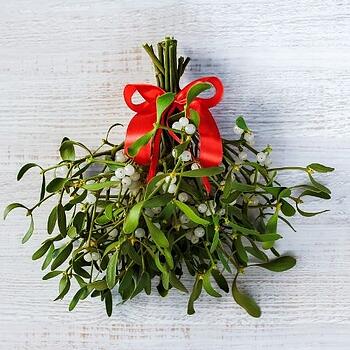
Before you pucker up to kiss your sweetheart, be sure that bunch of mistletoe is well secured to the door jam. Though a strategically-placed sprig of mistletoe may get you that Christmas "snog" you've been dreaming about all year, it may also land your dog or cat in the hospital if it falls to the ground or they find another way to get their paws on it.
Even when eaten in small quantities, mistletoe can cause excessive drooling and digestive upset.
But even bigger problems are in store for your pet if they ingest a larger quantity of this common Christmas decoration. In these situations, your pet may experience heart and/or neurologic problems, which could include abnormal heart rate and rhythm, decreased blood pressure, and a staggered walk. If left untreated, these signs can progress to collapse, seizures, coma, and even death.
Christmas Trees
Although fake trees are becoming increasingly popular, many people still get live trees and these can be hazardous to both dogs and cats.
- Both dogs and cats enjoy chewing on the limbs, and oils from fir trees can irritate the inside of their mouths, causing drooling and vomiting.
- Ingested pine needles can collect together, creating an intestinal obstruction or potentially puncturing the intestine, leading to a painful condition called peritonitis.
You can limit their access by placing an obstruction in their path. The Christmas Tree Defender works GREAT at preventing cats from climbing up a tree from the bottom! It can be used on other potted plants as well.
Get more tips on keeping your cat out of the Christmas tree!
Other Holiday Pet Hazards
Decorations
From cuts on paws from broken ornaments to gastrointestinal obstruction from decorations that get ingested, ornaments and other Christmas tree decorations pose a wide array of hazards to your pets.
Cats are probably most at risk of sustaining injuries with their propensity to bat down and play with things that dangle in front of them. This isn't to say that dogs aren't at risk of injury or illness.
Some simple steps include keeping your cat out of your tree, picking up fallen ornaments and cleaning up broken pieces, and never leave your pet unsupervised around your tree and the ornaments.
Light Strands & Electrical Cords
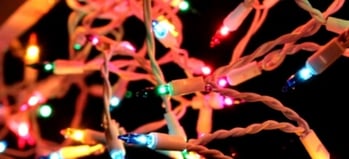
Before you assume that your pet doesn't have an affinity for anything shocking, keep in mind that it's the one time of year that we have more exposed cables and light strands adorning our home.
It's natural for both dogs and cats to chew, so don't assume that their normal behavior will be consistent with the holidays.
Pets that chew on electric cords can sustain burns on their tongues and elsewhere in their mouth. These pets may also develop a buildup of fluid within their lungs, as a result of the electrical shock. This fluid buildup within the lungs that results from a cause other than heart failure, is known as non-cardiogenic pulmonary edema, which can lead to breathing problems and can be fatal, too.
Signs that your pet may have suffered an electrical shock include abnormal behavior, hiding, excessive drooling, refusal to eat or drink, random or abnormal urination/defecation near an electrical cord, or evidence of a chewed electrical cord.
Tips to prevent your pet from experiencing electric shock:
- Recognize that puppies and kittens are the most likely pets to chew on electric cords. As such, use extra care with puppies and kittens in the house and be particularly careful not to have any electric cords near a puppy's crate.
- Be sure to unplug all strands of lights when you leave the house or before you go to bed at night. If you want the lights to be on when you wake up in the morning, plug them into a reliable timer.
- For the long 'tail' of the cord on the light strand (the portion without lights), consider using a protective covering such as The Chewsafe cord protector or the CritterCord to prevent the teeth of curious or mischievous pets from sinking in.
- To prevent fires, always check your cords for evidence of chew damage before plugging them in.
- If you have a pet that you're certain will attack the strands of lights, wrap only the top portion of your tree, consider using rope-type lighting instead, or don't use such lights in your home. Rope lighting can more easily be rubbed with a deterrent spray, such as Bitter Apple, to help decrease the chances that your pets will chew on it. Tip: Do not spray the deterrent product directly onto the lighting; rather, spray it on a cloth and then wipe the strand with the dampened cloth.
- Opt for lower voltage LED lights (rather than the traditional higher voltage incandescent type) to decrease the risk associated with a nibble on the cord. These bulbs are also often made of plastic rather than glass and are less likely to break and cause a laceration or cut-type injury.
Wrapping
Just like tinsel, ribbons and bows that adorn wrapped gifts and lay around with your wrapping supplies are typically quite enticing for cats. Something about these wrapping accessories just seems to trigger a cat's inner hunter. Unfortunately, a common result of this 'hunt' is an intestinal obstruction that can sicken or kill your cat.
If you think your cat has ingested something and might have an obstruction, look for these symptoms:- Refusal of food
- Decreased energy
- Hiding
- Vomiting
- Diarrhea or a lack of bowel movements
- Abdominal pain (often indicated by your pet’s growling, vocalizing, or attempts to bite when their abdomen is touched or you attempt to pick them up)
Treatment for linear foreign body obstruction should always involve surgery. Not just to remove the offending material, but to evaluate the gut for damage and tissue that is beyond repair.
If something is protruding from your pet's butt, read this to find out what to do! If you pull at what's sticking out you can cause further damage to your pet's digestive tract, including perforation of their bowel, with the result of bacteria and intestinal contents leaking into the abdominal cavity causing a painful and life-threatening inflammation and infection within the abdominal cavity called septic peritonitis.
Prevent bows and ribbons from becoming a Christmas cat-astrophe!- Don't leave wrapping supplies out where your pets can get to them. Either put all supplies away when you are done using them, or wrap all your presents in a room or area that you can close off to prevent your pet's access.
- Don't put gifts with ribbons and/or bows out under the tree until Christmas morning.
- Don't allow your pets around the tree while you're unwrapping presents or be very diligent to securely discard any ribbons and bows as soon as they come off the present they're adorning.
- Once all of the gifts are opened, take the trash bag containing ribbons and bows to your outdoor trash can for the most secure disposal.
- Don't allow your pets to play with the ribbons and bows, and advise your guests not to engage your pets in such play either.
- Skip the ribbons and bows for your holiday and gift decorating all together.
Potpourri
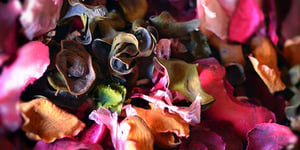
Potpourri (liquid or dry) can create or help to mimic wonderful holiday smells. While these oily liquids and dry concoctions can fill a house with a sensory overload of wonderful aromas without all the 'hassle' of baking cookies, lighting a fire, or cutting down a pine tree, they also pose a very real, and potentially very significant hazard to your pets.
Cats: Liquid potpourris typically contain two substances that can be toxic — essential oils and cationic detergents. While the essential oil component of the liquid potpourris can cause problems for your pets, typically it’s the cationic detergents that cause the bigger problems.
- The cationic detergents present in liquid potpourri can cause severe ulceration and chemical burns to the surfaces within your pet's mouth and along their digestive tract.
- They can cause similar problems if they come into contact with their skin or their eyes, too.
Dogs: Dry potpourri can contain a wide variety of fragrant dried herbs and flowers. The potential toxicity of such a mixture depends entirely on what plants are in it, but even nonpoisonous floral potpourri can irritate your dog’s gastrointestinal system and cause vomiting or diarrhea.
- If the potpourri mix includes harder items like miniature pine cones or bark chips, these could potentially lodge in your dog’s throat and cause breathing difficulties.
- Pine and other flora are toxic, but you might not be able to tell what each dried piece of potpourri is in a mix, especially since they're often artificially colored.
Batteries
Now you might not think that your dog would eat a battery, but given the frequency with which these types of cases are seen in pet emergency rooms and general practices around the country, it appears as though, for some reason, quite a few dogs just seem to love chewing on and swallowing these things!
AA, AAA, C, D, 9-volt, and other "traditional" battery types can result in injuries such as oral burns and/or digestive upset or obstruction — which are very serious in their own right — but it's the disc or "button"-type batteries that can pose an additional serious danger when swallowed — esophageal burns and perforations.
Learn more about button and other battery ingestion in dogs, including what to do and not to do if your dog swallows a battery, as well as view a time lapse video showing how button batteries can quickly burn a hole in the esophagus!
To avoid the animal emergency room this year, follow a few simple tips:- Don't leave remote controls of any type lying around where your pets can easily get them.
- Batteries are common stocking stuffers! Be sure to hang your stockings high and keep your pets well away from them.
- If they're old enough, talk with your children about the dangers of battery ingestion in pets and the importance of putting their toys away after they are done playing with them. (If your kids aren't old enough to understand this discussion, then you also likely need to be careful about their potential to ingest batteries themselves — this is one of those emergencies that isn't restricted to pets.)
- To prevent dropped batteries from rolling under the couch or desk, where they are likely to remain 'lost' until they turn up in your pet's stomach, always remove and change batteries over a bowl or sink.
- Appropriately and securely store your spare batteries in a drawer or toolbox.
While this list of holiday pet hazards may seem daunting or "overly cautious," you now have the knowledge and awareness to help you keep your pets happy at home — rather than at the Animal ER — this holiday season. Helping to ensure that your whole family can have a happy, healthy, safe holiday season and New Year!




